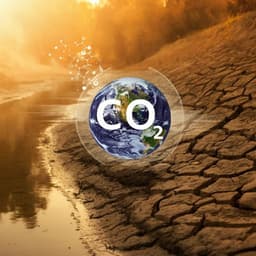
Environmental Studies and Forestry
Destabilization of carbon in tropical peatlands by enhanced weathering
A. Klemme, T. Rixen, et al.
Explore how enhanced weathering, a strategy to remove CO₂, could jeopardize tropical peatlands—important carbon sinks—by possibly flipping them into CO₂ sources. This intriguing research was conducted by Alexandra Klemme, Tim Rixen, Moritz Müller, Justus Notholt, and Thorsten Warneke.
~3 min • Beginner • English
Introduction
The study addresses whether applying enhanced weathering (EW) in tropical peatlands—identified as potential hotspots for CO2 drawdown due to warm, humid climates—could inadvertently destabilize existing carbon stocks. While EW aims to accelerate atmospheric CO2 uptake by converting CO2 to bicarbonate via silicate weathering and exporting alkalinity to the ocean, peat soils are naturally acidic systems where pH strongly regulates decomposition. Tropical peatlands in Southeast Asia (notably Sumatra and Borneo) have shifted from sinks to sources due to disturbance, making conservation and restoration central to climate pledges. The research investigates how EW-induced increases in pH and bicarbonate supply affect peat carbon mobilization and CO2 emissions across soils, peat-draining rivers, and adjacent coastal waters. The purpose is to quantify net regional impacts for Sumatra and assess whether EW in peat regions undermines CO2 removal goals.
Literature Review
Methodology
Study area and data: Sumatra has >70,000 km2 of peatlands (15.6% of its 464,301 km2 area). River data from Sumatra (Siak, Indragiri, Musi, Batang Hari; peat coverages 4.0–25.9%) collected in eight campaigns (2004–2013) and additional Malaysian Borneo rivers (Rajang, Simunjan, Sebuyau, Maludam; peat coverages up to 90.7%) from six campaigns (2014–2017) were used to construct and validate a river carbon box model. River parameters (CO2, O2, DOC, pH, temperature), gas exchange coefficients, catchment areas, peat coverages, stream surface areas (GRWL database or hydraulic scaling), precipitation (local data and APHRODITE) and discharges (precipitation minus evapotranspiration, with ET fractions per disturbance class) were compiled.
Enhanced weathering scenarios: EW estimates were based on basalt application scenarios from Taylor et al. and Beerling et al. For this study, moderate application rates were used: 1 kg m−2 yr−1 basalt over tropical regions and 4 kg m−2 yr−1 over Indonesian croplands. These yield CO2 uptake of 25–50 gC m−2 yr−1 and soil pH increases of 0.2–1.3 (lower than hotspot maxima). Assumed that captured CO2 is initially transformed to bicarbonate (HCO3−) and leached as DIC to rivers over time, with potential direct soil re-emission under acidic conditions.
Soil response calculations: In the absence of extensive tropical peat datasets, relationships between peat soil pH and carbon mobilization were taken from temperate peat studies at 15 °C (Kang et al.). CO2 emission response to pH is approximately linear: a 1 pH unit increase adds ~12 g CO2 yr−1 per kg peat; applied to upper 15 cm soil layer with bulk density 0.127 g cm−3. DOC leaching response to pH follows a non-linear negative exponential dependence on pH; a reference DOC leaching without EW was approximated as the sum of measured oceanic DOC export plus in-river DOC respiration. Direct re-emission of captured CO2 in acidic peat due to bicarbonate to CO2 conversion was parameterized at ~15% of applied inorganic carbon based on Finnish peat liming experiments with similar pH changes (converted to 3.8–7.5 gC m−2 yr−1 for the EW scenarios).
Leaching rate derivations: Natural DOC leaching into rivers approximated as oceanic DOC yield (DOC × discharge) plus in-river DOC loss via respiration (DOC × f_dec(O2,pH)), where f_dec is an O2- and pH-dependent decomposition function calibrated for tropical peat-draining rivers. Natural DIC leaching approximated as oceanic DIC yield plus atmospheric DIC outgassing minus DIC production by DOC respiration. Basin-wide DOC and DIC leaching for Sumatra were area-weighted from individual catchments and extrapolated across the island. EW-induced increases in leaching were added to these natural rates based on EW CO2 uptake (for DIC) and pH-induced DOC mobilization (for DOC).
River box model: A steady-state annual box model simulated DOC, DIC, carbonate alkalinity (CA), CO2, O2, and pH dynamics under fixed inputs: leaching rates (DOC, DIC, CA, O2), temperature (29 °C), freshwater salinity (0.001), discharge-to-volume (Q/V ~1.1×10−6 s−1), and gas exchange per depth (kw/d ~7.0×10−6 s−1). Processes included O2/pH-dependent DOC decomposition, gas exchange (CO2 and O2), carbonate equilibria (Zeebe & Wolf-Gladrow), and discharge. Natural runs (without EW increases) were validated against observed river concentrations and used to estimate baseline emissions. EW scenarios increased DIC (from weathering) and DOC (from pH mobilization) leaching. Uncertainties were evaluated via best/worst case respiration parameter sets.
Estuary and coastal mixing calculations: Estuaries (S ≤ 25; area 10,818 km2) and coastal ocean (25 < S < 32.8; area 127,674 km2) were treated as conservative mixes using salinity-derived river water fractions: α_est = 39.4%, α_coast = 12.4% (with S_est = 20, S_coast = 28.9, S_ocean = 32.8, S_river = 0.001). Estuarine/coastal DIC and TA were computed as linear mixes of river (from box model equilibrium) and ocean endmembers (DIC 1900 µmol L−1, TA 2200 µmol L−1). Assumptions: total river alkalinity equals carbonate alkalinity; all DOC oxidized upon entry to estuaries (DIC_discharge = DIC_river + DOC_river). CO2 concentrations were computed via CO2SYS; coastal air–sea CO2 fluxes used k600 = 12 cm h−1 and were scaled to estuary/coastal areas. Note: the approach assumes river water reaching the coast unchanged by estuarine emissions, likely overestimating upper bounds of coastal emissions.
Extrapolations: River CO2 emissions for Sumatra were derived by area-weighting individual river fluxes by stream surface coverage and catchment area, then scaling to island area. Natural and EW-perturbed leaching/exchange were used to compute changes in riverine emissions and oceanic DOC/DIC exports, feeding the estuarine/coastal flux calculations.
Key Findings
- Soil responses: For EW-induced soil pH increases of 0.2–1.3, peat soil carbon mobilization rises by 12–81 gC m−2 yr−1 as CO2 and by 13–109 gC m−2 yr−1 as DOC (case 1: all tropical peat soils). Even at the lower bound pH increase (0.2), added soil carbon mobilization can offset EW uptake; at the upper bound, mobilization greatly exceeds uptake. For Sumatra-wide application (case 2; peat coverage ~15.6%), peat areas alone add 2–13 gC m−2 yr−1 CO2 and 2–17 gC m−2 yr−1 DOC leaching, counteracting a large fraction of the 25–50 gC m−2 yr−1 EW uptake.
- Direct re-emission in soils: Under acidic peat conditions, 15% of captured inorganic carbon can be re-emitted as CO2, equivalent to 3.8–7.5 gC m−2 yr−1 for the EW scenarios; this accounts for 24–31% of the total EW-induced soil CO2 increase, with the remainder from enhanced decomposition.
- River dynamics: Natural Sumatra river CO2 emissions are 3.5–10.1 TgC yr−1 (observational estimate 6.9 ± 1.7 TgC yr−1). Increasing DIC leaching alone (25–50 gC m−2 yr−1) raises river CO2 emissions by 11–13% overall, up to ~32% for rivers with >30% peat coverage. Adding DOC leaching increases raises emissions further: with DIC leaching ~40 gC m−2 yr−1 and DOC leaching 2–17 gC m−2 yr−1, total river emissions increase by 20–75% over natural. Only 1–2% of DIC increase stems directly from carbonate input; 98–99% is due to pH-driven DOC decomposition.
- Oxygen and pH effects: EW-induced bicarbonate elevates river pH, enhancing DOC decomposition and CO2 production while reducing DOC and O2; in high-peat rivers (pH < ~5.2), O2 can approach lethal anoxia, limiting further decomposition despite higher pH.
- Oceanic exports: Natural oceanic exports from Sumatra are ~7.5 TgC yr−1 as DIC and ~4.6 TgC yr−1 as DOC. With EW, DIC export increases by 11–33 TgC yr−1 (combined DIC+DOC leaching scenarios), and DOC export changes by −1 to +4 TgC yr−1.
- Estuary/coastal emissions: Natural emissions are ~6.2 TgC yr−1 (estuaries) and ~5.4 TgC yr−1 (coastal ocean). With increased DIC leaching alone, coastal emissions initially decrease (due to higher pH and carbonate partitioning) but exceed natural when DIC leaching ≥12 gC m−2 yr−1; for EW-range DIC leaching, emissions rise by 20–70% (2.4–8.2 TgC yr−1 total). Adding DOC leaching (2–17 gC m−2 yr−1) with DIC ~40 gC m−2 yr−1 increases total coastal emissions by 70–380%. Across the EW ranges, total coastal emissions increase by 8–44 TgC yr−1 (2–25 TgC yr−1 estuaries; 6–19 TgC yr−1 coastal ocean).
- Sumatra case synthesis: EW increases soil CO2 emissions by 1.2–6.6 TgC yr−1, river emissions by 0.9–7.4 TgC yr−1, and coastal emissions by 4.2–45.9 TgC yr−1 (1.0–24.7 estuaries; 3.2–21.2 coastal ocean). Land-based re-emissions (soils+rivers) reduce net EW uptake by 18–60% (with 86–95% due to carbon mobilization and DOC decomposition). Including coastal emissions, re-emission is at least ~50% and potentially >150% of EW uptake, implying possible complete offset.
Discussion
The findings demonstrate that, in tropical peat regions, the core mechanism that makes EW attractive (raising alkalinity and pH to store CO2 as bicarbonate and export it seaward) triggers biological and geochemical feedbacks that destabilize the existing peat carbon reservoir. EW-induced pH increases stimulate phenol oxidase activity, accelerating peat decomposition and DOC mobilization in soils. In peat-draining rivers, added bicarbonate elevates pH, which further enhances DOC mineralization to CO2 and drives significant riverine outgassing; in acidic waters, part of weathering-derived bicarbonate can convert back to CO2 prior to ocean export. Resulting O2 depletion, especially in high-peat catchments, reveals potential ecological risks and imposes a nonlinear limit on further decomposition.
Along the land–ocean continuum, higher riverine DIC export and pH can transiently suppress coastal emissions via carbonate partitioning, but the increased inorganic carbon supply from enhanced DOC mineralization ultimately dominates, increasing estuarine and coastal ocean CO2 emissions. Consequently, the regional carbon budget in peat-rich tropical landscapes shifts such that land and coastal re-emissions can substantially negate, or even exceed, the atmospheric CO2 removal attributed to EW. These results directly address the research question by showing that EW in tropical peatlands is likely counterproductive for net CO2 removal and may exacerbate carbon losses from valuable natural carbon sinks, with implications for national accounting and climate mitigation strategies.
Conclusion
Applying moderate enhanced weathering in tropical peat regions like Sumatra is projected to increase CO2 emissions from soils (16–89 gC m−2 yr−1) and, via altered riverine carbon dynamics, to elevate river and coastal emissions sufficiently to offset a substantial fraction or even all of the intended CO2 drawdown. For Sumatra, land-based re-emissions reduce EW CO2 uptake by 18–60%; including coastal emissions raises re-emission to at least 50% and potentially >150% of uptake. The dominant mechanisms are pH-driven peat decomposition and DOC mineralization, with only a minor fraction of additional riverine DIC arising directly from carbonate inputs. These results indicate tropical peatlands should be excluded from EW deployment to avoid destabilizing peat carbon stocks and creating coastal CO2 sources. Future research should quantify soil-type-specific responses to EW, particularly DOC leaching and decomposition kinetics under tropical conditions, refine coastal carbon flux estimates with more detailed estuarine–shelf processes, and develop deployment guidelines that avoid adverse biogeochemical feedbacks.
Limitations
- Soil process parameterization relies on temperate peat relationships (15 °C) due to limited tropical peat data; responses at tropical temperatures may differ (possibly weaker).
- Direct CO2 re-emission estimates are based on boreal peat liming experiments; applicability to tropical peat requires validation.
- River gas exchange coefficients (k values) are variable and uncertain; standardized ranges were used, potentially affecting absolute fluxes.
- Coastal emission calculations assume conservative mixing and full oxidation of DOC upon estuary entry and do not deduct estuarine emissions from river inputs to the coastal ocean, likely overestimating upper bounds of coastal emissions.
- Island-wide extrapolations assume representativeness of sampled rivers and constant parameters across diverse catchments and seasons.
Related Publications
Explore these studies to deepen your understanding of the subject.







